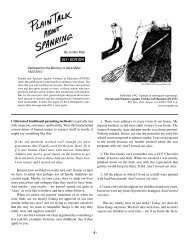By Jordan Riak - Project NoSpank
By Jordan Riak - Project NoSpank
By Jordan Riak - Project NoSpank
Create successful ePaper yourself
Turn your PDF publications into a flip-book with our unique Google optimized e-Paper software.
and the earlier the mistreatment, the worse the outcome.The Gluecks also<br />
found that the lowest incidence of antisocial behavior is associated with children<br />
who are reared from infancy in attentive, supportive, nonviolent families.<br />
The message here for all parents is a simple one: if you want to do<br />
everything within your power to prevent your child from one day joining the<br />
prison population, guide gently and patiently. Remove shaming, shouting,<br />
ignoring, threatening, insulting, bullying and spanking from your parenting<br />
tool kit. .<br />
Spanking and prejudice .<br />
Spanking fills some children with anger and the urge to retaliate. But this<br />
urge is almost never directly acted upon. Even the most severely spanked<br />
children, as a general rule, will not strike back at those who have hurt them.<br />
Instead, they are likely to seek relief in fantasy where they can safely vent<br />
their anger against make-believe adversaries. Sometimes bullying and acts of<br />
cruelty against younger siblings or family pets serve this purpose. Much<br />
popular entertainment aimed at young audiences caters to this need.<br />
As children grow and come under the influence of prejudices within their<br />
community, their anger can be easily channeled toward scapegoated groups.<br />
Hate cults and extremist political factions and sects beckon to them with<br />
open arms, offering an opportunity to convert fantasy into reality. In every<br />
generation, more than a few seize that offer.<br />
Spanking and brain development .<br />
In early childhood, the brain develops faster than any other organ in the body.<br />
<strong>By</strong> age 5, the brain reaches about 90 percent of its adult weight, and by 7, it<br />
is fully grown. This makes early childhood a very sensitive and critical period<br />
in brain development. .<br />
Stress caused by the pain and fear of spanking can negatively affect the<br />
development and function of a child’s brain. It is precisely during this period<br />
of great plasticity and vulnerability that many children are subjected to physical<br />
punishment. The effect can be a derailing of natural, healthy brain growth,<br />
resulting in life-long and irreversible abnormalities. .<br />
According to researcher Dr. Martin Teicher of McLean Hospital in<br />
Massachusetts, “We know that an animal exposed to stress and neglect in<br />
early life develops a brain that is wired to experience fear, anxiety<br />
and stress. We think the same is true of people.” (From “Child Abuse Changes<br />
the Developing Brain,” Yahoo! News, Dec. 29, 2000.) .<br />
In Teicher’s article, “The Neurobiology of Child Abuse,” Scientific<br />
American, March 2002, he writes, “...New brain imaging surveys and other<br />
experiments have shown that child abuse can cause permanent damage to<br />
the neural structure and function of the developing brain itself. This grim<br />
result suggests that much more effort must be made to prevent childhood<br />
abuse and neglect before it does irrevocable harm to millions of young victims<br />
(p. 70)... Society reaps what it sows in the way it nurtures children... (p.<br />
75).” See www.nospank.net/mteicher.htm .<br />
No responsible parent would deliberately jeopardize a child’s normal<br />
brain development, yet that is precisely what spankers unwittingly do. .<br />
Spanking at school .<br />
The disciplinary hitting of students in the United States typically involves<br />
battering the buttocks with a flat board called a paddle. At the time of this<br />
writing, the practice is legal in 19 states. It should be understood that paddling<br />
is not the only method used to inflict pain on students. Forced exercise and<br />
denial of use of the bathroom, for instance, are commonly used as forms of<br />
painful punishment. But paddling, because it is specifically prescribed and so<br />
blatant, serves to overshadow and thereby give cover to less obvious forms<br />
of abuse. .<br />
Corporal punishment is deemed by its users and defenders to be in students’<br />
best interests and essential to the smooth functioning of the<br />
school. Were that true, schools that are the most punitive would be the highestperforming,<br />
students who are routinely punished would be the best behaved,<br />
and teachers’ colleges would teach paddling. In fact, school systems with the<br />
highest rates of corporal punishment are the worst-performing, students who<br />
are the most punished are the most troubled and difficult to manage, and there<br />
is not one accredited teachers’ college in the United States that instructs future<br />
educators in the proper method for hitting people. Documented research shows<br />
a correlation between school corporal punishment and certain negative social<br />
outcomes. States that have the highest rates of school paddling also have the<br />
lowest graduation rates, the highest rates of teen pregnancy, the highest<br />
incarceration rates and the highest murder rates. See “Correlation between<br />
high rates of corporal punishment in public schools and social pathologies,”<br />
2002, at www.nospank.net/correlationstudy.htm<br />
The use of corporal punishment in schools also has a demoralizing effect<br />
on teachers who don’t condone the practice. They have difficulty working<br />
alongside paddlers. Their survival in such an environment depends on their<br />
willingness to remain silent about what they witness. They know that paddlers<br />
feel threatened by their very presence. It’s not unusual for a paddling school<br />
to degenerate to a level where it is nothing more than a magnet and safe<br />
haven for incompetent teachers, including some who are dangerously unfit to<br />
8 9





